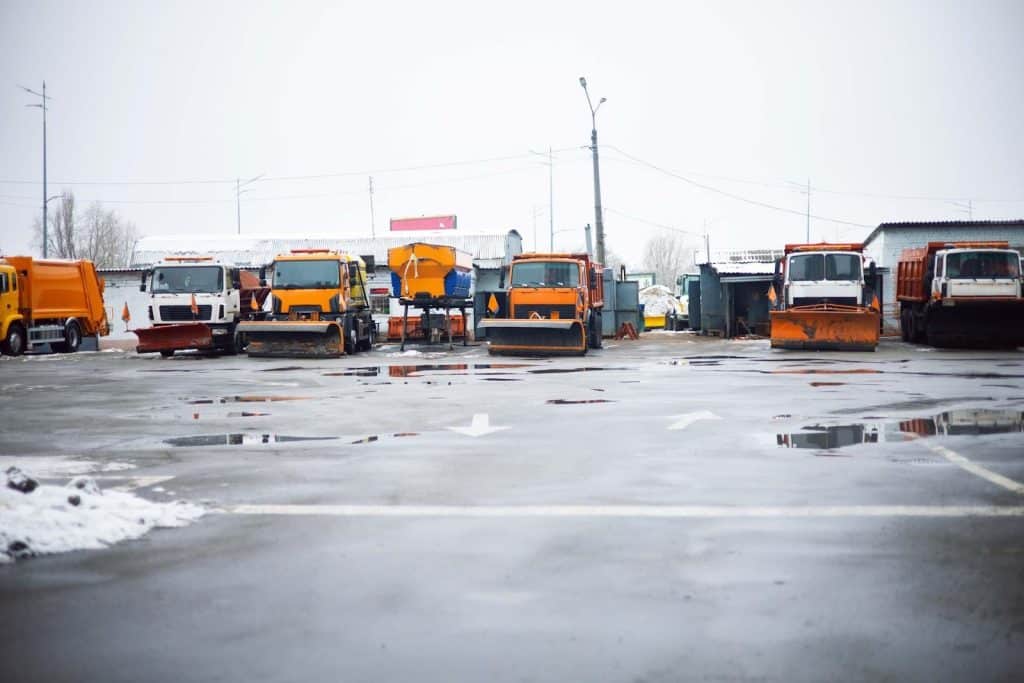
In the bustling world of municipal operations, the efficiency of your fleet can be the linchpin of success, dictating everything from cost savings to the quality of services delivered to your community.
Let’s face it: Fleet maintenance isn’t exactly the most glamorous task to manage. However, it can be easier with the advent of innovative solutions like the 1st Reporting app. Fleet management has evolved from a cumbersome chore into a streamlined process that’s as precise as it is powerful.
In this article, we’ll delve into the top 10 tips for maintaining your municipal fleet like a pro, ensuring that your operations run smoother than a freshly oiled engine.
Whether you’re a seasoned fleet manager or new to the role, these tips will empower you to enhance efficiency, reduce costs, and keep your fleet in top-notch condition. So, buckle up and get ready to transform your fleet maintenance strategy into a well-oiled machine of municipal efficiency.
Understanding Municipal Fleet Maintenance

In my years of experience working with municipalities and their facilities and fleets, I’ve seen equipment last and fail that should have lasted. But of all the municipal buildings I worked in, one stuck out in my memory—not because of some crazy experience I had, but because the fleet repair shop was immaculate. In fact, I thought the team had recently moved into the building because everything was in such an organized state.
Since visiting the finely tuned fleet repair operation I just described, I have come to view fleet maintenance in a different light. I define municipal fleet maintenance as inspections, predictive repairs, and preventive management of commercial vehicles or mobile, self-propelled equipment.
Efficient operations and fleet management are critical for city or municipal managers to run an efficient and efficacious operation. So, it’s prudent to define workflows that maximize efficiency while prioritizing team member safety. Using my tips for efficient municipal fleet maintenance; you can do just that.
Tips for Efficient Municipal Fleet Maintenance Management

There are over 35,700 township and municipal governments in the United States alone. (1) Consider what a five or even 10% improvement in fleet maintenance and management would mean for the country. You can do your part by considering these tips.
- Don’t Neglect Regular Inspection and Preventive Maintenance Scheduling
Use scheduling to your advantage and create a systematic calendar of events to ensure that your fleet is on track and in top working order. When I managed a fleet of service trucks, I found that using a digital calendar and reminders was a great way to stay on top of all the various inspections required on specialized fleet equipment.
Schedule Routine Inspections
Routine inspections are crucial to maintaining equipment, as you know. But did you know that as much as 7.9% of vehicles receive delayed routine maintenance? (2) That’s nearly 10% of vehicles that are being under-serviced.
Use Preventive Maintenance
Preventive maintenance means inspection, observation, documentation, and replacement of wearing, worn, or timed-death parts. When I say ‘timed-death’, what I mean is that if you track vehicle and equipment wear against known equipment part lifespan, then you can set timers for replacing certain parts. For example, you may have certain asset parts like tires that have a predictable operable lifespan. So, replacing these parts prior to their known expected lifespan saves you the hassle and challenge of emergency repairs, which in many cases could be more expensive.
- Make Implementing a Fleet Management Solution a Priority
Benefits of Fleet Management Software
Dedicated fleet management software is great, but in my experience, it often has a learning curve and a number of faults. However, the concept is sound: take advantage of current software development and implement a digital solution to help you manage your fleet. Proper organization is always a bonus and even a necessity of successful fleet maintenance management.
How ‘1st Reporting’ Enhances Fleet Maintenance

1st Reporting is a mobile application built for organizations and municipalities like yours to create customized forms, checklists, and reports and enable those documents to be completed by team members in the field using mobile devices. Furthermore, the application has a variety of features that can make fleet management more straightforward. Whether you want to track pre-use vehicle inspection results, fleet maintenance or repair requests, or even vehicle-related incidents, with the customizable nature of the app, you can handle a lot more than just fleet maintenance.
- Utilize Enhanced Training for Fleet Personnel
Importance of Proper Training
I cannot stress this tip enough: ensure your team members and stakeholders have adequate training. However, let me be clear by defining adequate training in this context. In my experience, adequate training means sufficient training to make your team members comply with organizational goals and regulations. So, I don’t think that the bare minimum classifies as enough. I often find that more training is always better than less, but good training is hard to come by, so if you find good training companies to partner with, don’t let go of those contacts.
Topics to Cover in Training
Essential training is obviously necessary for mechanics in order to complete fleet maintenance properly. However, if you can ensure that drivers and vehicle or equipment operators are adequately trained to know what to look for in their fleet pre-use inspection and when operating the equipment, a smart operator can save your fleet division a fortune in repairs if they can observe appropriately and report back.
- Provide Methods of Efficient Documentation and Reporting
Digital vs. Paper Documentation
Compare digital and paper documentation methods, and you’ll see that paper falls short of being acceptable to today’s business standards. Today’s maintenance work orders should include and make use of the latest technologies, but at a minimum, they should include photos or even videos showing wear with a clear explanation of observations. Technology today can easily transcribe on your mechanic’s behalf, enabling you to get clearer documentation with valuable media to substantiate and provide a clear avenue for data-backed decision-making.
Utilizing ‘1st Reporting’ for Documentation
The 1st Reporting app streamlines documentation with mobile devices. Mechanics, service personnel, or anyone appointed in your organization can easily document fleet maintenance activities, including media, as mentioned above. Add in additional reporting KPI features, and you’ll have a robust system to manage fleet maintenance, incidents, inspections, and any other event requiring documentation.
- Take Advantage of GPS Tracking for Fleet Vehicles
44% of online respondents to a poll by Fleet News said their fleet drivers used smartphones or tablets for vehicle management. (3) Considering that most people these days use their smartphones for GPS navigation, it stands to reason that fleets will do the same, phasing out standalone GPS navigation devices for the smartphones everyone carries today instead.
Benefits of GPS Tracking
GPS tracking improves route efficiency and reduces fuel costs if you are observing and optimizing routes as necessary. Most fleets use either standalone GPS systems or those who want to take advantage of the very smartphones they provide to their fleet operators.
Integrating GPS and the 1st Reporting App
The 1st Reporting app’s GPS capabilities enhance fleet management. Unlike fleet trackers, 1st Reporting instead tracks reporting. So, when a fleet operator completes a pre-use vehicle inspection, for example, the app notes the time and location of the report creation, giving you the insight to manage accordingly. Coupled with vehicle tracking solutions, you’ve got a powerful toolkit for managing a mobile fleet.
- Customizable Digital Forms for Specific Fleet Maintenance Needs
Let’s run with the trend of smartphone use. This tip assumes that your fleet also uses smartphones. Try trading off a paper form like the daily vehicle inspection report and use a digital form instead. Why? Here’s a few good reasons:
Advantages of Custom Forms
- You can quickly adapt custom digital forms to your specific fleet and municipal needs.
- Dissemination of digital forms is instant using secure cloud storage and mobile reporting technologies like the 1st Reporting app.
- Customized forms mean that you decide which fields are required (forced form field completion before proceeding), forcing fleet operators to abide by the document requirements.
- Add features like the 1st Reporting app’s relationship element (in their form builder/customizer). You can create powerful, automated workflows that don’t stop at a single step, like a daily pre-use fleet vehicle inspection.
- Regularly Review and Update Your Fleet Policies
All fleet managers are concerned with costs. Rightfully so, I understand why, especially coming from my decades of experience managing mobile service teams (and the fleet they operated). According to research, (4) the primary variables that add to the bulk of fleet costs are:
- Fuel
- Maintenance
- Tires
- Repairs
- Depreciation
I point out these expenses because they directly affect and add to the overall fleet expenses.
Keeping Policies Current
It’s crucial to review fleet expenses regularly and track all fleet maintenance and associated costs. By doing so, you can update maintenance policies regularly to evolve with your municipality’s needs.
Using Data to Inform Policy Changes
The key to regularly reviewing and updating fleet policies is to make any changes based on data. Making actionable decisions backed by data does two things:
- It forwards your municipality or organization toward its associated goals and
- It backs up your decision-making process.
- Solve Efficient Fleet and Equipment Inventory Management
Tracking Spare Parts and Supplies
The need for efficient inventory management is paramount for cost-effective maintenance and repair management. Try implementing a robust inventory control system to ensure that this part of the fleet maintenance process is cost-effective and efficient.
Inventory Management Features in the 1st Reporting App
The 1st Reporting app boasts a powerful form customizer and builder. It means that you can create custom inventory forms and have your team complete them using a mobile device. This method of replacing the traditional paper and clipboard is much more efficient and effective than paper and pen. Furthermore, with integrations like Microsoft Teams® and Microsoft Power BI®, you can share, collaborate, and visualize data about your fleet, your inventory, and anything else you use the app to manage. Now, that’s what I call intelligent inventory management.
- Reduce Downtime with Prompt, Responsive Repairs
Importance of Quick Repairs
I don’t need to tell you that prompt response to fleet repair needs, fleet incidents, accidents, and emergencies can improve downtime. By reducing downtime, you reduce costs. However, quickly responding to these events is a challenge if your management processes have any roadblocks (no pun intended).
Using the 1st Reporting App to Respond to Fleet Events
When I managed a fleet, I found that when something with a fleet vehicle went wrong, the easiest way to manage effectively was to get as much information as fast as possible to make informed decisions. Using pen and paper or relying solely on a driver’s opinion is equally risky, especially if your drivers see these events as a way of getting out of work while still getting paid.
The 1st Reporting app has a solution: a powerful and customizable notification system. You decide the trigger, the recipient, and the message. So, when a driver starts to complete a fleet repair request, for example, you can get notified before they have a chance to complete the request form. Now, that’s what I call fast. If you can think of a faster way than instant notifications to help you respond faster to fleet events, I’d love to hear about it.
- Monitoring Fuel Efficiency and Other Expenses
Fuel Management Strategies
Making use of fuel tracking and management can help you to lower expenses. Fuel is the primary expense for fleet use, so ensuring you have a good handle on the efficient use of fuel can make or break your fleet budget. I recommend using an app like 1st Reporting to track fuel use via a simple custom refueling form you could implement as a requirement for your team of fleet operators. Include refueling amounts and vehicle mileage, and you’ve got a great start on making fuel use more efficient in your fleet operations.
Role of the 1st Reporting app in Fuel Efficiency
As mentioned, the 1st Reporting app seamlessly integrates with some of Microsoft’s most popular business collaboration and data visualization tools. By integrating forms like fleet vehicle pre-use inspections with mileage tracking, refueling, and repair request forms, you can create a customized solution for managing all of your fleet costs, not just maintenance.
Wrapping Up Your Fleet’s Efficiency Tune-Up

Maintaining an efficient municipal fleet is more than a task—it’s a critical component of successful municipal operations. By implementing these top 10 fleet maintenance tips, you can ensure that your fleet operates smoothly, cost-effectively, and reliably.
Leveraging innovative tools like the 1st Reporting app can transform your maintenance strategy, making it more streamlined and effective. From regular inspections to efficient documentation and GPS report tracking, the 1st Reporting app offers a comprehensive solution tailored to your needs.
Integrating these tips into your operations is the first step towards revolutionizing your fleet maintenance. Your community deserves the best, and with these strategies, you can deliver excellence in organizational or municipal fleet management. To learn more about how the 1st Reporting app can support your maintenance goals, request a demo today and discover the future of fleet management.
Article Sources
- Smaldone, Amy, and Mark L.J. Wright. 2024. “Local Governments in the U.S.: A Breakdown by Number and Type.” @Stlouisfed. Federal Reserve Bank of St. Louis. March 14, 2024. https://www.stlouisfed.org/publications/regional-economist/2024/march/local-governments-us-number-type#:~:text=In%20the%20most%20recent%20Census,township%20and%20municipal%20governments%2C%2012%2C546.
- Bill. 2017. “Automotive Research Study: Consumers’ Vehicle Maintenance.” IMR. September 10, 2017. https://www.automotiveresearch.com/insights/consumers-delaying-vehicle-routine-maintenance.
- “Fleets Get Smart with Mobile Phone Technology.” 2015. Fleetnews.co.uk. October 2015. https://www.fleetnews.co.uk/fleet-management/fleet-software/fleets-get-smart-with-mobile-phone-technology#:~:text=Meanwhile%2C%20what%20applies%20to%20the,while%203%25%20were%20planning%20to..
- Shukri, Ahmad, Ruzanna Mat, Aishah Ramlan, and Mohamad Anuar. 2013. “An Overview of Fleet Maintenance and Operating Cost: Key Components and Methods.” ResearchGate. Unknown. December 31, 2013. https://www.researchgate.net/publication/261713668_An_Overview_of_Fleet_Maintenance_and_Operating_Cost_Key_Components_and_Methods.